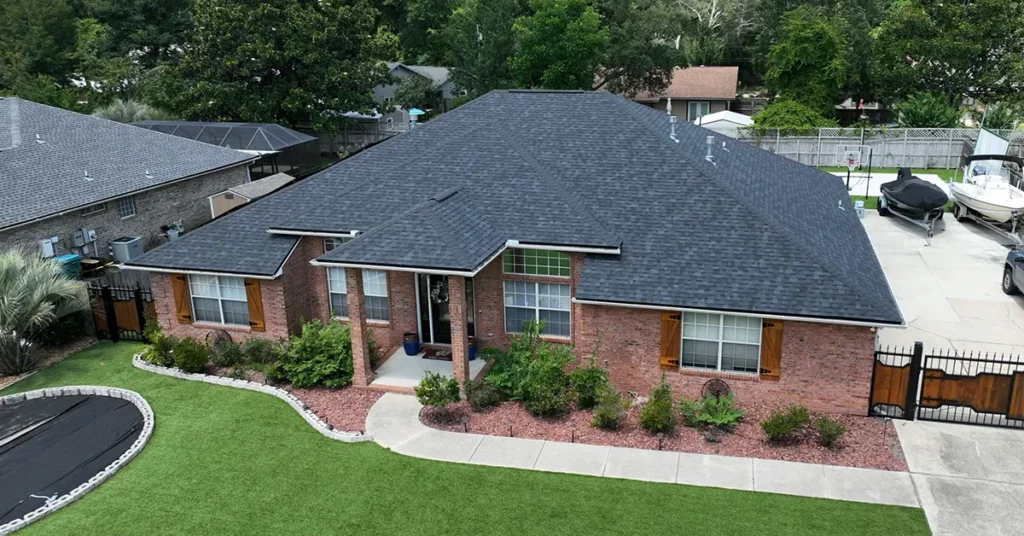Most of us don’t think about our roof until something goes wrong. A leak, a missing shingle, or a big storm reminds us that the roof is working hard up there every single day. But how long does it last? That depends on the material, the weather, and how well it’s taken care of.
In this blog, we will discuss the average lifespan of common roofing materials, what affects their longevity, how to tell if your roof is in trouble, and what you can do to help it last as long as possible.
Why You Should Know How Long Roofs Last
Your roof protects everything inside your home. It keeps out water, wind, sun, and snow. Over time, though, even the strongest roof starts to wear down. If you know how long a roof typically lasts, you can plan ahead and avoid being caught off guard by costly repairs or replacements.
Roof replacements are not cheap, but they give you peace of mind. You’ll sleep better knowing your roof can handle what’s coming.
Roofing Lifespans by Material
Here is a breakdown of the most common roofing materials and how long each one usually lasts when installed and maintained properly.
Asphalt Shingles
Expected lifespan: 15 to 30 years
This is the most common roof type in many residential neighborhoods. It is budget-friendly and easy to install. There are two main types: standard three-tab shingles and thicker architectural shingles. Three-tab shingles usually last about 15 to 20 years, while architectural shingles often hold up for 25 to 30 years or more.
In hot climates, asphalt roofs tend to wear out faster due to UV rays. Poor attic ventilation or the buildup of leaves and moisture can also shorten their lifespan.
To help these roofs last longer, clean them once or twice a year. Look for any missing or damaged shingles and replace them early before leaks start.
Wood Shingles and Shakes
Expected lifespan: 20 to 50 years
Wood shingles are smooth and cut evenly. Shakes are thicker and rougher, giving a more rugged look. Cedar is the most popular wood because it naturally resists bugs and moisture.
These roofs work best in dry climates. In areas with lots of rain or humidity, the wood can absorb water, swell, and rot. Regular maintenance is key. These roofs need cleaning, sealing, and sometimes fire-resistant treatments.
To extend their life, keep trees trimmed, allow sunlight to reach the roof, and make sure no moss or mold builds up.
Metal Roofing
Expected lifespan: 40 to 70 years
Metal roofs are very durable and can last a long time. Aluminum and steel panels often last 40 to 60 years. Copper and zinc roofs can last even longer, sometimes well over 70 years, if installed properly.
Metal resists fire, snow, and high winds. It reflects sunlight, which can help lower energy bills in hot climates. However, metal roofs need proper installation. Water can get in if the fasteners are loose or seams are not sealed well.
It’s important to check for rust or loose screws once or twice a year. Keeping the surface clean and roof inspecting the flashing around chimneys and vents can prevent long-term damage.
Clay Tile Roofing
Expected lifespan: 50 to 100 years
Clay tiles are strong and long-lasting, and they are often seen on homes in warmer climates. They can withstand sun, wind, and fire, and they rarely rot or warp. With proper care, a clay tile roof can last over 100 years.
However, clay tiles are heavy. Your home needs to be built to support the weight. They are also brittle, meaning they can break if someone walks on them or if something heavy falls during a storm.
To protect your clay roof, stay off of it as much as possible. Clean out the valleys between tiles and replace any broken pieces quickly to avoid leaks.
Concrete Tile Roofing
Expected lifespan: 50 years or more
Concrete tiles look similar to clay but usually cost less. They are also heavier and even more resistant to impact and storms. These tiles can handle extreme heat and do not catch fire.
Their main weakness is the material underneath, called underlayment.
Even if the tiles are in good shape, the underlayment might wear out after 20 years. When this happens, water can seep through.
Inspect your concrete roof every couple of years to get the most out of it. Ensure the tiles are in place and the underlayment is still working.
Slate Roofing
Expected lifespan: 75 to over 200 years
Slate is one of the most durable roofing materials. Made from natural stone, it gives homes a classic, elegant look. A properly installed slate roof can last longer than a person’s lifetime.
Slate roofs are also fireproof and not affected by pests or moisture. However, they are cumbersome, so not every home can support them.
These roofs require very little maintenance, but repairs can be expensive and require a skilled roofer. If one tile cracks, it’s best to have it replaced as soon as possible.
Flat Roofing
Expected lifespan: 10 to 30 years
Flat roofs are common in modern homes and commercial buildings. They can be made of different materials, such as rubber (EPDM), thermoplastic (TPO), or tar and gravel (built-up roofing).
Flat roofs are more prone to leaks because water does not run off as easily. Pooling water, UV damage, and foot traffic all shorten their lifespan.
To extend the life of a flat roof, keep it clean. Clear drains and remove debris. Have a roofing contractor check the surface annually and apply protective coatings as needed.
Tips to Make Your Roof Last Longer
A roof’s life depends on its material and how well you care for it. These simple actions can add years to your roof’s life, no matter what it’s made of.
Inspect Your Roof Twice a Year
Set a reminder to check your roof in the spring and fall. Look for missing or curled shingles, rust spots, sagging areas, or anything that looks wrong. You do not have to climb on the roof. You can often spot problems from the ground using binoculars or a camera zoom.
Clean Your Gutters Regularly
One of the main causes of roof damage is clogged gutters. When water cannot flow through, it pools on the roof or backs up under the shingles. This can lead to leaks, mold, and even rotting wood. Clean your gutters every few months, especially when leaves are falling in the fall. Make sure downspouts are also clear and carry water away from your foundation.
Trim Back Tree Branches
Overhanging branches drop leaves and rub against your roof during storms. That can break shingles or damage tiles. In some cases, heavy branches can fall and cause major damage.
Keep tree limbs trimmed at least a few feet away from the roof. This allows more sunlight to reach the roof, which helps dry out moisture and reduce moss growth.
Keep the Attic Well Ventilated
Your attic needs to breathe. Without good airflow, heat and moisture build up inside. This can weaken the roof from underneath and make shingles wear out faster. Make sure vents are not blocked. If your attic feels very hot in the summer or damp in the winter, talk to a roofer or contractor. You may need better insulation or more ventilation.
Don’t Ignore Small Repairs
It is easy to overlook a small crack or one missing tile. But over time, water will find its way in. A tiny leak can turn into a big headache. Water damage inside your home can cost thousands to fix. If you spot a problem, call someone to fix it right away. Small fixes cost less and help your roof last longer.
FAQs
How do I know when my roof needs to be replaced?
Look for missing shingles, water stains on ceilings, sagging spots, or light in the attic. If your roof is over 20 years old, it’s time for a professional inspection.
What is the longest-lasting roofing material?
With proper care, slate roofs last the longest, often over 100 years. Metal and clay tile roofs also have long lifespans of 50 years or more.
Does weather affect how long a roof lasts?
Yes, extreme heat, snow, hail, and heavy rain can all shorten a roof’s life. Roofs in milder climates usually last longer with less wear and tear.
Can I extend the life of my roof without replacing it?
Regular inspections, clean gutters, attic ventilation, and quick repairs help extend roof life. Maintenance matters more than most people think.
How much does it cost to replace a roof?
Costs vary by material and home size, but most homeowners spend between $5,000 and $15,000. Premium materials like slate or metal cost more.
Is it okay to walk on my roof to check for damage?
It’s not recommended unless you’re trained, and it’s safe to do so. Walking can damage tiles or shingles, and falling is a real risk. Use binoculars instead.
Conclusion
The answer to how long roofs last depends on many things. Material matters, but so does where you live, how the roof was installed, and how you take care of it. Asphalt might last 20 years. Slate can last over a century. But all roofs need attention now and then.
Knowing what to expect helps you plan for the future. With simple care and regular checks, your roof will protect your home for as long as possible.


